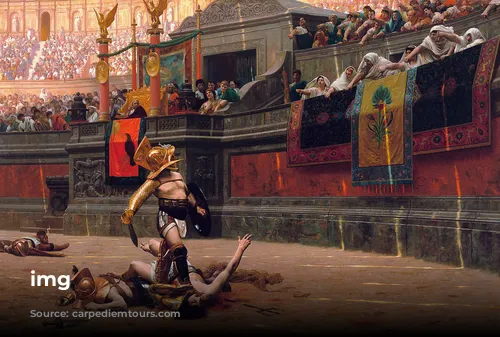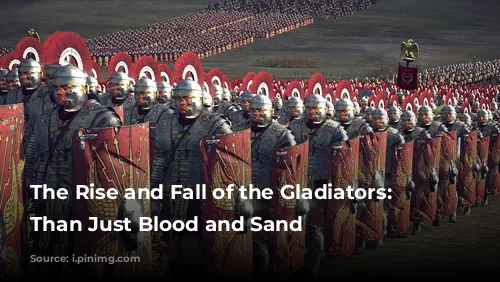Gladiator, Ridley Scott’s epic film, reignited our fascination with ancient Rome and its gladiatorial celebrities. The film, starring Russell Crowe as the vengeful general-turned-gladiator Maximus, vividly portrays the life of a gladiator in ancient Rome. But how accurate is this portrayal?
Beyond the Blood: The Art of Ancient Entertainment
It’s easy to view gladiatorial contests as mere barbaric blood sports, but this perspective is inaccurate. The Romans valued skill, sportsmanship, and spectacle in their games, just like modern fans of professional wrestling. We often forget that these contests were a central part of Roman society, deeply embedded in their culture and traditions.
The Origins of Gladiatorial Combat
Gladiatorial fights evolved from ancient funeral rituals. Re-enactments of great battles, known as munera, were a common feature at funerals of prominent figures. These re-enactments, featuring hand-to-hand combat and chariot races, showcased the deceased’s bravery and achievements. By the 3rd century BC, these munera evolved into popular entertainment, attracting large crowds.
The Roman Empire’s expansion and conquests brought in a steady influx of slaves and prisoners of war, providing a pool of potential gladiators. These captives were often forced into gladiatorial combat as a form of entertainment and a display of Roman power.

The Rise of the Colosseum: A Symbol of Imperial Power
During the Roman Empire, hosting gladiatorial contests became a crucial way for emperors to showcase their generosity and popularity amongst the people. Emperor Vespasian, recognizing the importance of public displays of magnanimity, began construction of the Colosseum, the largest amphitheater in the Roman Empire, in 70 AD. The Colosseum was completed by his son Titus, who celebrated its grand opening with 100 days of games.
For over 300 years, the Colosseum served as the epicenter of gladiatorial combat in the Roman Empire. The citizens of Rome were captivated by the spectacle, and gladiatorial fights became a central part of their lives.
The Gladiators: More Than Just Slaves
Contrary to common belief, gladiators were not always forced into fighting. While some were indeed slaves or prisoners of war, many gladiators were professional fighters who signed contracts with their trainers, known as lanista. These contracts typically lasted for five years, during which they trained rigorously. Successful gladiators could earn their freedom or buy their way out of slavery if they were financially successful.
Gladiators gained immense fame and fortune, attracting the attention of Romans from all walks of life. Spartacus, the most famous gladiator, exemplifies this phenomenon. He was a skilled warrior who led a rebellion of slaves against the Roman Empire.
Beyond the Gladius: A Variety of Gladiators
The term gladiator literally means “swordsman” and originates from the gladius, the standard Roman sword. While the gladius was a popular weapon among gladiators, different types of gladiators wielded a variety of weapons and armor.
Each type of gladiator had its own distinct look and fighting style. The Murmillo, like Spartacus, wore a plumed helmet with a face guard, while the Retiarius fought with a net and trident. The Secutor, armed with a gladius and a large shield, was a formidable opponent.
Like modern boxing, gladiatorial combat emphasized skill and bravery rather than outright brutality. These contests were overseen by a referee, who enforced the rules of the game. Unfortunately, the exact rules of these fights have been lost to time.
The Myth of Death Matches
Despite the popular image of bloodthirsty crowds demanding death matches, the reality was far less gruesome. While some gladiators undoubtedly lost their lives, these executions were rare and mostly reserved for criminals or prisoners of war. Gladiator fights themselves were expensive and only occurred a few times a year.
It was more profitable to keep gladiators alive for future contests. These fighters were like modern-day sports stars, attracting large crowds and generating revenue. The financial incentives meant that killing a gladiator was rarely in anyone’s best interest.
The Importance of Games in Ancient Roman Life
It’s essential to understand the social context of gladiatorial combat to fully grasp its significance. Roman society was deeply intertwined with its military traditions, and these games were more than just entertainment.
Imagine working long hours with little to no time off. Now picture a government-sponsored holiday featuring free entertainment, food, and gifts. This is the reality for the average Roman citizen who eagerly awaited these spectacles as a respite from their daily lives.
The gladiators were more than just fighters; they were heroes, entertainers, and symbols of Roman strength and power. Their contests reflected the values and aspirations of Roman society, a society deeply influenced by its military history and a yearning for a temporary escape from the harsh realities of daily life.
